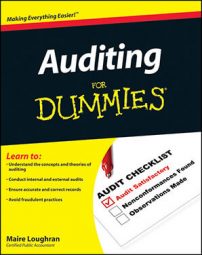From the initial client interview all the way down to issuing the audit report, as an auditor you have to keep a record of all the work you do. This information is kept in the audit file and shows the basis for the conclusions you reach. Here you learn about the types of documents that go into an audit file, as well as who ultimately owns that file. (Here’s a hint: It’s you!)
The audit file comes in many shapes and forms, all of which you classify as either permanent or current.
The permanent audit file
You carry forward documents in the permanent file from year to year. They form the base for planning the subsequent year’s audit. Most of the info in the permanent file doesn’t change from one year to the next.
Here are documents for you to keep in the client’s permanent file:
Copies of the company’s incorporation documents: Businesses have to file articles of incorporation, which cover the basics about the company such as its name, address, the stock it issues (what type and how many shares), and the registered agent.
The type of information a state needs for the incorporation is a matter of state statute.
Chart of accounts: You use this numerical listing of all the client’s asset, liability, equity, revenue, and expense accounts as a sort of road map to figure out where certain accounts should be showing up in your client’s general ledger.
The general ledger shows all the accounts in the chart of accounts and lists what transactions affect them during the year under audit.
Organization chart: This document shows the levels of management from the head honcho all the way down to the lowest member of the staff.
Accounting manual: The manual provides an overview of how the accounting functions of a company work. It provides a guide to the responsibilities of each accounting department and how accounting employees should do their jobs.
Copies of important leases or contracts: You should have a copy of the contracts for any property, plant, or equipment the company leases. You use this information to verify rent expense on the financial statements. Any major contracts with suppliers, customers, or unions are also kept in the permanent file.
Internal control documentation: Any records you keep or write-ups you do during the evaluation of the company’s internal controls are kept in the permanent file.
Stock and bond issuances: These documents list the number of shares outstanding and give information on the terms of any bonds.
Prior years' analytical procedures: Use these documents to see whether plausible and expected relationships exist in both financial and nonfinancial data from year to year.
The current audit file
You’ll also have a current file, which contains all your work on this year’s audit. Here are some examples of things you expect to see in the current file:
Audit plan: Your road map for conducting the current year audit is definitely included in the current file. This plan includes your understanding of the client, the allocation of firm resources, and your risk assessments.
Working trial balance and workpapers: A really simple explanation of a trial balance is that it’s a chart of accounts with ending balances for each account. The purpose of the trial balance is to show that the fundamental accounting equation (assets = liabilities + owners’ equity) is satisfied.
Journal entries for the client: You also keep track of all adjusting and reclassification entries you give to the client.
Your firm owns all audit documents it prepares. It doesn’t make any difference that the client paid for the audit; the documentation isn’t the client’s property.
The Public Company Accounting Oversight Board’s (PCAOB) basic requirement is that you keep audit documentation for a period of seven years unless a longer period is required by law. This requirement includes any documents that are created, sent, or received that contain opinions, financial data, or conclusions about the audit or review. Nonpublic companies aren’t required to follow the PCAOB’s rules. However, many state accounting boards have adopted similar retention policies. Your firm will more than likely follow PCAOB standards for all audits — public and nonpublic.

